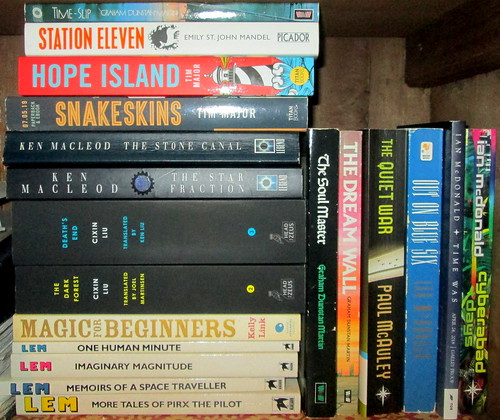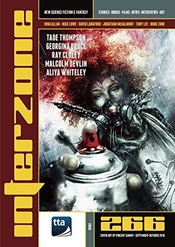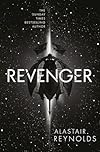Gollancz, 2009, 503 p, including 3 p Introduction by Paul McAuley.
This is a collection of Reynolds’s short(ish) stories from the early part of his writing career. They vary in length from short story to novella.
The Real Story is a beautifully well-thought out and executed tale of an investigation by journalist Carrie Clay into the whereabouts many decades later of the first man to land on Mars. His was a solo project which almost went catastrophically wrong and caused him profound psychological problems. There is a great set piece where the pair of them base jump from Mars’s premier city into that deep scar across the Martian surface, Valles Marineris.
Beyond the Aquila Rift is set in a universe where barely understood technology left behind by aliens allows interstellar travel. Sometimes, though, there are routing errors. Our narrator ends up beyond the local bubble in the Milky Way, beyond the Aquila Rift.
In the framing device of Enola the remnants of humanity live out their lives terrified of the alien enolas reining down destruction from the skies. The middle section of the story, the meat in the sandwich, contains the recollections of the last of the enolas, AI weapons of mass destruction but capable of reasoning with one another.
The world of Signal to Noise is one where correlators can “cold-call” similar machines in other realities, resonate with and lock on to them to allow information transfer. In the wider world implanted nervelinks can connect one body to the sensory inputs of another, sedated, body, giving control over it. In his world, Mike’s wife dies in an accident. His friend, Joe Liversedge, works in the correlation unit – where they were about to try nervelinking between worlds – and gives him the opportunity to interact with his estranged wife’s counterpart in a newly correlated other world. But the signal fades with time.
Cardiff Afterlife is set in the same milieu as Signal to Noise a few years later. Joe Liversedge doesn’t like the use the governments (and the parallel universes’ governments) are making of the correlation capability and sets out to do something about it.
The far future of Hideaway is one in which humans have long left Earth and its location has long been forgotten. The remnants of the Cohort, on a ship called the Starthroat, are in a decades long flight from a species known as the Huskers. When a Husker fleet is also detected in front of them the crew is forced to head for a likely planetary system to hide out. Unfortunately the star and the system’s biggest planet have unusual activity in them. The details of this involve some speculative physics. The story is told in five parts. For some reason in my proof copy parts 3-5 were in italics while 1 and 2 had been in a normal typeface.
In Minla’s Flowers, Merlin, a survivor from the previous story, is thrown out of the Waynet, an ancient interstellar transport system. He is forced to seek aid on a planet of a nearby sun, whose inhabitants’ technology is at the biplane/airship stage. He discovers the Waynet will intersect with the system’s sun in about seventy years. He drops them hints about physics so that they will be able to develop the means to leave for another world, coming out from ‘frostwatch’ cold sleep every fourteen years or so to see how things are going. The story has an embedded reference to Margaret Thatcher’s “no such thing” comment about society.
Merlin’s Gun is a third story featuring Merlin. Here Sora survives an otherwise devastating Husker attack only for her familiar to shut her down in frostwatch for three thousand years – relativistic time-scales are one of Reynolds’s characteristics – waking her up only when a likely rescue ship enters the system where she is hidden. Merlin takes her on his quest to find the ‘gun’ which will allow the Huskers (whose true nature is revealed here) to be defeated. Reynolds’s knowledge of the SF genre is exemplified when he calls the gun ‘a weapon too dreadful to use’.
In Angels of Ashes aliens called the Kiwidinok, whose perception of quantum reality differs from that of humans, came to Earth and revealed to a “lucky” volunteer, Ivan, the remnants of a nearby neutron star whose formation ‘miraculously’ spared Earth the radiation devastation. The Kiwidinok suddenly left again. Ivan became the inadvertent Founder of a new religion but he is now on his deathbed and wishes his truth to be known.
Spirey and the Queen is another story set during an age-old interstellar war, where Von Neumann machines nicknamed wasps have evolved into consciousness but its main thrust is concerned with protagonist Spirey – from a branch of humanity which is entirely female – and her endeavours to survive while on a mission to kill a traitor and her discoveries about the reasons for the war continuing.
Understanding Space and Time is for some strange reason printed in italics. Its subtitle, Mars ain’t the kind of place to raise your kids…, is a tip of the hat to the holographed Piano Man who appears in the story, complete with Bösendorfer grand. He appears to John Renfrew, the last survivor of humanity, in a habitat on Mars. Renfrew has little to do but converse with the holograph and use the few books available to try to understand space and time. With the later help of Aliens called the Kind who resurrect him from mummified death centuries after he suffers an accident on the Martina surface he spends his days, years and centuries, unlocking the layers of reality.
Digital to Analogue is, in effect, about an ear-worm which is akin to a virus, propagating via the sampling of a music track, and may be a new life-form.
Everlasting explores a ramification of the many worlds theory. Moira drives hurriedly through the snow to Ian’s house as he had talked on the phone about not killing himself. There he expounds his notion that in every dangerous branching of the worlds there will always be one where there is an unlikely survival and that he is therefore effectively immortal. Then he produces a revolver with one round in it. The twist in this tale is not hard to foresee but is arguably inevitable in any case.
Zima Blue is a story about memory and belonging, the tale of a universe-renowned artist called Zima, body adapted to endure the most extreme environments – interstellar vacuum, the pressures of gas giants etc – famous for the increasing vastness of his works (to the scale of moons,) and the particular blue colour he always employs. He gives his final interview to the Carrie Clay of The Real Story earlier in this book and produces his final, very much scaled down, artwork.
Pedant’s corner:- In the Introduction; “That’s doesn’t mean” (That doesn’t,) “that begin in a different times and places” (in different times,) “none of the stories … are” (none … is.) Otherwise; “none of my expectations were actually contradicted” (none … was,) epicentre (centre,) overlaying (overlying,) “the atmospheric gases became steadily more fluidic” (gases are already fluids; they flow. I think Reynolds meant ‘steadily more like liquid’,) “to condense the air into its fluid state” (ditto; liquid state,) “glimpsed_moving”, “added_some”. “Slammed_Tyrant”. “The_closer”, (I have no idea what those underslashes are for, and another appeared in a later story) “‘with the things I’ve showed you’” (shown,) “letters in Lecyth us A marched in stentorian ranks across the high vertical face” (how ranks of alphabetical symbols can be loud is something of a puzzle.) “The music reached its crescendo now.” (No. The crescendo is the rise, not its climax,) “where gouged by” (were gouged by,) “had opened a rosewood box and showed them to him” (shown,) “like kneeling orisons” (I didn’t know invocations/acts of supplication to a deity could kneel,) “I understood the math” (Oh, please. It’s ‘the maths’,) “‘as it conveniences us’” (no need for the ‘it’,) one story’s afterword has no indents at a new paragraph. “The moment reached a kond of crecscendo” (No. It reached a kind of climax,) smidgeon (smidgin, or, smidgen, but in any case, the word has no ‘o’ in its spelling,) “for old time’s sake” (times’,) “finding that the scene was established in Newcastle made up for the wrench” (‘the scene that was established’ makes sense of this,) a new paragraph that is not indented, “than any prescience on my behalf” (on my part,) Sacks’ (Sacks’s.)
 Reynolds can be relied upon to give us good, solid well-written SF. This is a departure from his usual galaxy-spanning Space Opera epics though; a tale of environmental catastrophe and time travel.
Reynolds can be relied upon to give us good, solid well-written SF. This is a departure from his usual galaxy-spanning Space Opera epics though; a tale of environmental catastrophe and time travel.
 Spearpoint is a tiered city whose tip reaches beyond the atmosphere. Post-human angels (though they call themselves human and the other inhabitants pre-human) occupy the Celestial Levels and ride thermals with their wings. These are where the most advanced technology still works. Angels are feared, even hated, by those in the levels below. Down the tiers – through Neon Heights, Steamtown and Horsetown – the transition between different zones is debilitating or worse (requiring anti-zonal drugs to ameliorate the symptoms) and technology becomes progressively unusable. From time to time the zone boundaries quiver or shift due to disturbances in The Mire, aka the Eye of God, the chaotic origin point for the zones. A religious text called the Testament seems to allude to this.
Spearpoint is a tiered city whose tip reaches beyond the atmosphere. Post-human angels (though they call themselves human and the other inhabitants pre-human) occupy the Celestial Levels and ride thermals with their wings. These are where the most advanced technology still works. Angels are feared, even hated, by those in the levels below. Down the tiers – through Neon Heights, Steamtown and Horsetown – the transition between different zones is debilitating or worse (requiring anti-zonal drugs to ameliorate the symptoms) and technology becomes progressively unusable. From time to time the zone boundaries quiver or shift due to disturbances in The Mire, aka the Eye of God, the chaotic origin point for the zones. A religious text called the Testament seems to allude to this.











